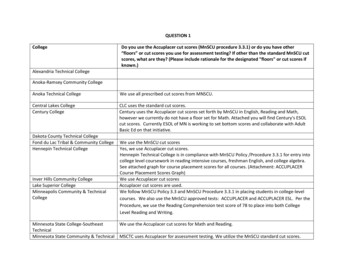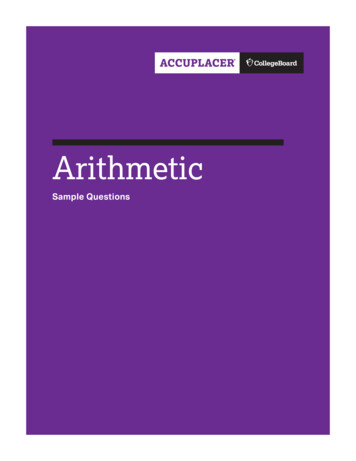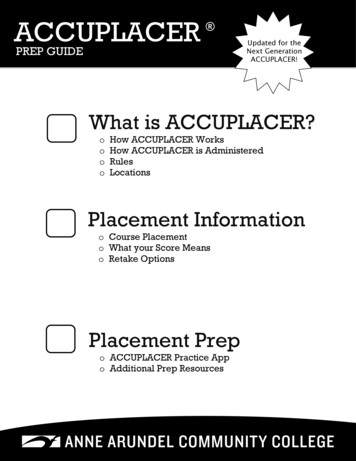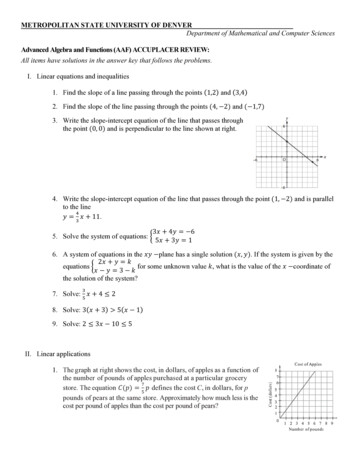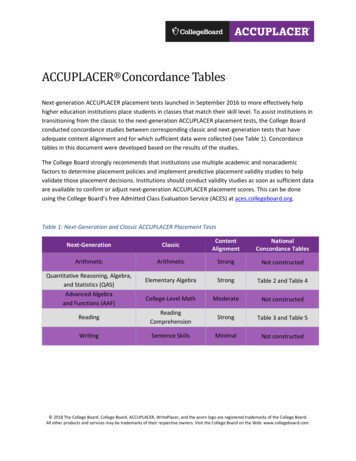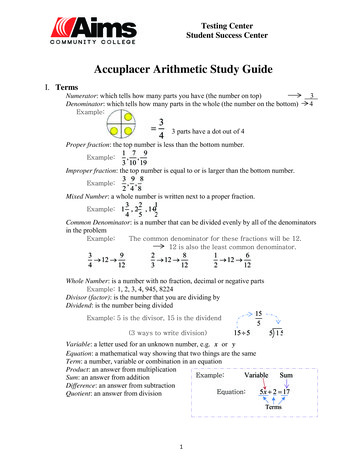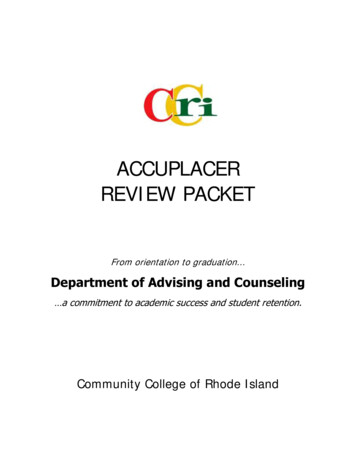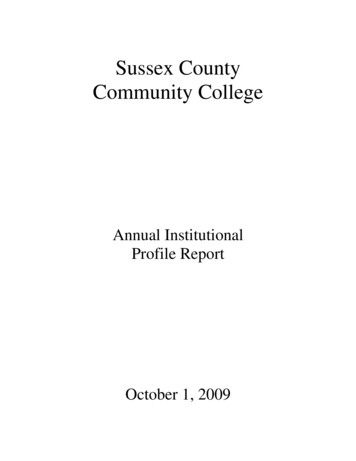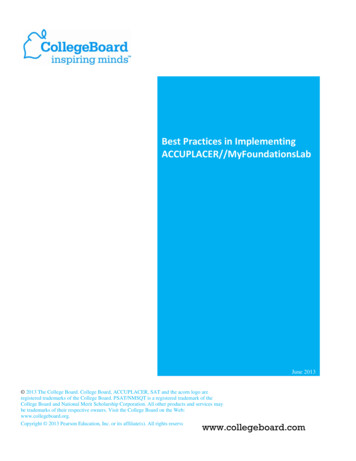
Transcription
Best Practices in ImplementingACCUPLACER//MyFoundationsLabJune 2013 2013 The College Board. College Board, ACCUPLACER, SAT and the acorn logo areregistered trademarks of the College Board. PSAT/NMSQT is a registered trademark of theCollege Board and National Merit Scholarship Corporation. All other products and services maybe trademarks of their respective owners. Visit the College Board on the Web:www.collegeboard.org.Copyright 2013 Pearson Education, Inc. or its affiliate(s). All rights reserved.www.collegeboard.com
Table of ContentsTable of Contents . 2Introduction . 3Implementation Planning . 4Roles and Responsibilities . 7Technical Considerations . 9Time Requirements . 9Educator Professional Development . 10Implementation Workflow . 10Best Practices in Implementing ACCUPLACER//MyFoundationsLab2
IntroductionWhat is ACCUPLACER//MyFoundationsLab? Why use it?ACCUPLACER//MyFoundationsLab is a blend of ACCUPLACER Diagnostics tests that provide data todeliver an individualized, online intervention curriculum through MyFoundationsLab to enhance studentcollege readiness in preparation for placement into either developmental or college-level course work.Enhancing students’ college readiness in order to reduce or eliminate developmental, non-credit courses incollege has a major, positive impact on the issues of college affordability, retention, completion andgraduation.Possible Implementations of onsLab is a flexible computer-based intervention solution that can bedelivered to students in a variety of ways. The implementation process begins with students takingACCUPLACER Diagnostics and then using those results to automatically create an individual learningpath in MyFoundationsLab. Students can work at their own pace on assigned content that includes bothinstructional activities and assessments. As activities are completed, MyFoundationsLab is tracking eachstudent’s progress using metrics such as time-on-task, activity scores, number of attempts, and mastery ofassessments. Teachers and administrators can review all of this data to monitor progress and provide justin-time instruction as needed to supplement the courseware. At the end of the intervention period, scoresfrom MyFoundationsLab can be used to evaluate college readiness in conjunction with ACCUPLACERtesting. Diagnostics can be administered again as a posttest to determine growth in each domain, orplacement tests can be used to determine if students meet the required cut scores for their intendedcolleges.Because ACCUPLACER//MyFoundationsLab is computer based, it can be used in any location that hasappropriate hardware and Internet access. Possible scenarios include the following: Independent study can be beneficial, particularly for graduates who wish to use the summer after highschool to prepare for placement testing before starting college. By taking ACCUPLACER Diagnosticsat their high school or through their college, students can work at their own pace to enhance their skilllevel and potentially place into higher levels of course work immediately.Guided independent study is useful in both high schools and colleges in which scheduling interventionas part of a class is not possible. Students can work at their own pace with ongoing monitoring byfaculty who can provide assistance and support as requested.Integrating ACCUPLACER//MyFoundationsLab into classroom instruction blends online learning withthe ongoing curriculum. Students can work on their own individual learning paths to build skills thatsupport the ongoing curriculum; teachers can select topics that match their instructional goals; or a mixof both.A lab class provides time for students to work on their individual learning paths with an instructoravailable to monitor progress and provide assistance as required. Many colleges allow students toBest Practices in Implementing ACCUPLACER//MyFoundationsLab3
register for a lab class, and then exit from the class with full credit once they have completed allcontent assigned in ionsLab can be used to meet a variety of goals surrounding college readiness,and teachers can use data from ACCUPLACER Diagnostics to drive intervention and tailor instruction forprograms, classes and/or individual students. The online content of MyFoundationsLab delivers anindividual learning path for every student based on his or her needs. Possible uses of this powerfulcombination include the following: ACCUPLACER//MyFoundationsLab can serve as an instructional component of college summer bootcamp experiences designed to prepare incoming students for placement testing.College developmental education courses benefit from ACCUPLACER//MyFoundationsLab’s abilityto provide individualized instruction that speeds a student’s progress through the course. Content canalso integrate with ongoing instruction as an additional resource beyond a textbook.Colleges can offer ACCUPLACER//MyFoundationsLab in area high schools as part of their outreachto prospective students to increase preparedness for placement testing and potentially reduce theamount of developmental education required.Individual high schools and/or school districts find ACCUPLACER//MyFoundationsLab a powerful,flexible tool that can enhance their efforts to ensure students are considered college ready beforegraduation.Adult education programs that strive to prepare adults for college enrollment in credit-bearing courses.Implementation PlanningSuccessful implementations of ACCUPLACER//MyFoundationsLab begin by creating a plan that definesthe goals to be achieved, how success will be measured, the student population to be served, how testingwill be accomplished, the means of providing access to the content and how access to technology will beprovided.Defining GoalsThe beginning of the planning process is defining the goals to be met by the implementation ofACCUPLACER//MyFoundationsLab. How will success be measured? Will it be by the number of studentsplacing into college level courses? Will it be by reducing the number of developmental courses required?Will it be increased performance on content domains as measured by ACCUPLACER Diagnostics?Identifying the Student PopulationWhile serving all students would be ideal, due to limited resources such as staffing, schedule, andavailability of technology, most campuses must make decisions about which students to target withACCUPLACER//MyFoundationsLab. Not only are students who plan to attend college candidates forintervention but also those who are heading into career or vocational programs in which meeting aplacement score is required.Best Practices in Implementing ACCUPLACER//MyFoundationsLab4
Students Planning to Attend a College Using Placement TestingUpon matriculation most students, even those attending four-year institutions, will face a placementprocess with the potential to take remedial instruction before moving to college level, credit-bearingcourses. Being prepared in advance through access to ACCUPLACER//MyFoundationsLab can help allstudents reduce or eliminate the need for these courses, saving both time and money.Students Not Meeting PSAT/NMSQT or SAT College-Readiness BenchmarksAs part of its suite of college readiness programs and assessments, the College Board has researched anddefined benchmark numbers on both the PSAT/NMSQT (currently a composite of 133 for 10th-gradersand 142 for 11th-graders) and SAT (currently a composite of 155) that indicate whether a student’sperformance is on track to be considered college ready. Targeting students who fall below thosebenchmark numbers will help them to close the gap in college readiness as they finish high school.Students in Academic DifficultySchools have a wealth of data about student performance including course grades and state test scores.Utilizing ACCUPLACER//MyFoundationsLab with students of average and below-average achievementcan make a significant difference not only in their college readiness but also in their success in the highschool curriculum by filling gaps in their knowledge and providing additional practice on core academicskills.Students Not Necessarily Planning to Attend CollegeMany students do not plan or expect to attend college yet make last-minute decisions to enroll, particularlyat community colleges. Using ACCUPLACER//MyFoundationsLab can ensure that all students have theacademic preparation to move into college-level course work more quickly.Students in Early or Middle-College High School ProgramsMany high school students plan to participate in dual-enrollment programs that allow them to earn highschool and college credit concurrently, yet they may not have completed prerequisite course work or met acollege’s placement requirement. Using ACCUPLACER//MyFoundationsLab can build the knowledge andskills required for successful placement and qualification for college level course work offered throughdual enrollment.Measures of SuccessIdentifying measures of success based on objective data is important to the implementation ofACCUPLACER//MyFoundationsLab because it provides guidance on which strategies work to improvestudent achievement and which strategies need fine-tuning for the next iteration of the intervention. Inaddition, some measures of success, such as comparing pre- to posttest scores, require scheduling ofadditional assessment that must be considered in the intervention timeline. Success can be measured inmany ways:Best Practices in Implementing ACCUPLACER//MyFoundationsLab5
One measure of success is to evaluate the performance data generated byACCUPLACER//MyFoundationsLab of students as they work through their assigned learning path.Each topic assigned contains not only instructional activities but also an assessment that can be used todetermine whether a student has mastered an entire topic. This metric includes the final score andwhether the topic is considered to be mastered.Because ACCUPLACER//MyFoundationsLab requires pretesting with ACCUPLACER Diagnostics,administering Diagnostics at the end of the intervention period allows a pre- to posttest comparison ofscore domains for individual students as well as the entire cohort. Because of the computer-adaptivenature of ACCUPLACER, students will likely receive different test items of higher difficulty on theposttest that will measure the gains they have made.Because one of the main purposes of ACCUPLACER//MyFoundationsLab is to increase placementlevels, one measure of success is to compare pre- to posttest placement scores. Growth can be definedas either the point gains made on each test by individual students and the cohort as a whole or as theinitial course placement as compared to the final course placement. Use of pre- to post-placementscores would require administration of ACCUPLACER placement tests in addition to Diagnostics.In high schools that can establish a data-sharing agreement with their local colleges, comparing thepercentage of students placing into each level of course work before and after use ofACCUPLACER//MyFoundationsLab can provide insight into the success of an intervention. Anadvantage to this approach is that students do not experience additional testing but instead go throughthe placement process at the colleges as normal.Defining Instructional StrategiesA key consideration for implementing ACCUPLACER//MyFoundationsLab is the instructional strategy orstrategies to be employed. These can be based on many factors including students targeted, purpose ortimeline of the intervention, building or campus schedule, instructional staff available and technologyavailable.Independent StudyThis instructional model allows students to work completely on their own in theACCUPLACER//MyFoundationsLab online intervention curriculum. No provision is made for dedicatedclass time or access to hardware; students must provide their own computer and must manage their ownlearning without access to a teacher.Independent Study with GuidanceThis instructional model allows students to work on their own in the ACCUPLACER//MyFoundationsLabonline intervention curriculum while also receiving some monitoring and guidance from a teacher. Noprovision is made for dedicated class time or access to hardware; students must provide their owncomputer and must manage their own learning with minimal support.LabThis instructional model allows students to work on their own on the ACCUPLACER//MyFoundationsLabonline intervention curriculum while receiving ongoing monitoring and guidance from a teacher. Access toBest Practices in Implementing ACCUPLACER//MyFoundationsLab6
technology is provided on a regular basis as part of a scheduled class or a required lab time outside ofclass.Blended LearningThis instructional model allows the teacher to manage the pace of the intervention program and assignmentof MyFoundationsLab content so that it integrates with ongoing instruction in a course. Access totechnology can be provided in class or be required outside of class. A teacher provides ongoing guidanceand monitoring of student achievement.Roles and ResponsibilitiesAs with any project, various roles and responsibilities must be performed in order to have a successfulimplementation. Depending on the personnel available, these tasks may be accomplished by differentindividuals or may be made with just one or two people.Role of the Institution Administrator or Site ManagerWithin ACCUPLACER, the roles of institution administrator and site manager are crucial to setup of theaccount for testing, including user creation, customization of test setup and overseeing the testing process.This individual may be in a college testing center or could be a lead individual in a high school or schooldistrict.Role of the ProctorIn ACCUPLACER, the proctor is a professional staff member responsible for administering andmonitoring testing. Proctors may be part of a college’s test center staff or be high school teachers,counselors and/or administrators.Role of the InstructorUse of ACCUPLACER//MyFoundationsLab shifts the role of the instructor from a lecturer responsible forpresenting content to a coach who assists students with questions, monitors student achievement, providesmotivation and celebrates success. This role is critical to students’ success particularly for those who lackthe motivation and discipline to perform independently. Suggested instructional activities include: Reviewing data from ACCUPLACER at the conclusion of Diagnostics testing to understand the needsof individual students as well as the entire cohort.Monitoring data in the MyFoundationsLab gradebook to see that students are making sufficientprogress and identifying topics that are difficult for individual students or the entire group. Dataavailable includes time on task, dates and times activities are completed, activity scores, number ofattempts, mastery of topics based on end-of-topic mastery tests, individual student averages and classaverages. Tools in the grade book allow instructors to review individual answers to questions fromactivities in the same way they can grade a paper-based test; this is useful in understanding where astudent may be having difficulty with a topic.Best Practices in Implementing ACCUPLACER//MyFoundationsLab7
Conferencing with students on an ongoing basis. This is a strong strategy that engages students indiscussion of their achievement to provide suggestions for improvement and opportunities to celebratesuccess.Assisting students on an as-needed basis when they encounter difficulty with content presented throughMyFoundationsLab. Frequently, clarifying an instruction on the screen or answering a question just-intime can allow students to continue working successfully on their learning path.Ongoing review of student achievement data. Doing so can help identify topics that a group or even anentire class is having trouble understanding. The teacher can provide a mini lesson to clarify theconcept for those students then let them return to MyFoundationsLab with a better understanding.Role of LeadershipAs with all instructional programs, leadership at the building, program or campus level is critical tosuccessful implementation of ACCUPLACER//MyFoundationsLab. Several different areas are important: Advocating for college readiness on behalf of students is essential, particularly at the high school level.Students, teachers and parents are typically focused on high school graduation, meeting state-testingrequirements, etc., and may not understand the ramifications of underperforming on college placementtesting or the value of the opportunity to prepare in advance.Setting goals and making decisions about the various options available to implementACCUPLACER//MyFoundationsLab is important to providing a successful intervention experiencethat will enhance student achievement.Assembling the necessary resources for successful implementation includes providing adequatestaffing, adequate technology in sufficient quantity to serve the number of students participating andfunding required for access to ACCUPLACER and MyFoundationsLab.Monitoring the implementation as it progresses is essential and can be accomplished throughconversations between faculty and students. In addition, reviewing data fromACCUPLACER//MyFoundationsLab platforms can provide insights beneficial to the overallinstructional program and curriculum in addition to understanding the status of individual students andthe cohort as a whole.Role of Counselors and Academic Advisors Advocating for college readiness on behalf of students is essential, particularly at the high school level.Students, teachers and parents are typically focused on high school graduation, meeting state-testingrequirements, etc., and may not understand the ramifications of underperforming on college placementtesting or the value of the opportunity to prepare in advance.Communicating with parents and students about the requirement for placement testing at the collegesstudents hope to attend is essential. Frequently they do not know about these requirements and are notaware of the potential for students to place into multiple levels of developmental course work thatslows degree completion and raises the cost of a higher education.Best Practices in Implementing ACCUPLACER//MyFoundationsLab8
Monitoring the implementation as it progresses is essential and can be accomplished throughconversations with faculty and students as well as reviewing data available from both ACCUPLACERand MyFoundationsLab.Role of Information/Educational Technology SpecialistsTechnology specialists play a critical role in ensuring that ACCUPLACER//MyFoundationsLab, as anInternet-based solution, operates smoothly. Depending upon the requirements of a particularimplementation, they may also act as institution administrators or site managers for ACCUPLACER.Technical ConsiderationsACCUPLACER//MyFoundationsLab is a blended solution that relies on two independent Web-basedplatforms: ACCUPLACER, which assesses students through Diagnostics, and MyFoundationsLab, whichdelivers online content. Both run via Web browsers running on industry-standard hardware. Specifichardware requirements for ACCUPLACER can be found here:www.accuplacer.org/cat/SystemRequirements.do and for MyFoundationsLab erall technical considerations include: ACCUPLACER Diagnostics must be given in a proctored environment and, therefore, must beadministered on campus in a testing center or a computer lab or on classroom computers.MyFoundationsLab does not need to be proctored, so while instructor monitoring is critical to success,it can be used anywhere including in computer labs, on classroom computers or off campus at home orin libraries.Adequate access to appropriate technology to meet the demand is necessary. The number of studentsshould be considered as well as the type of access: lab, classroom, individual laptop, etc. Dependingupon the time frame selected for access to MyFoundationsLab (10 weeks or 12 months), students mayneed significant time in the courseware to make the progress desired.Hardware should be configured properly with appropriate versions of required plug-ins. A browsercheck for each platform is available from the links above.Time Requirements Each of the four ACCUPLACER Diagnostics is composed of 40 questions. Although untimed, eachtest takes approximately an hour to complete. Students typically perform better when testing is dividedacross two to three days, especially if they are taking all four tests. In each test, the Save and FinishLater link is available, which allows students to save their place and return later.Students will be most successful if they work on the content assigned through their MyFoundationsLablearning paths on a consistent, ongoing basis. Each topic assigned requires approximately an hour tocomplete so students with more topics suggested may need substantial time to make measurableBest Practices in Implementing ACCUPLACER//MyFoundationsLab9
progress.o Mathematics has 77 possible topics based on the Arithmetic and Elementary AlgebraDiagnostics.o Reading has 20 possible topics based on the Reading Comprehension Diagnostics.o Writing has 20 possible topics based on the Sentence Skills Diagnostics.o Study Skills has 20 topics available for supplemental instruction.Educator Professional DevelopmentProfessional Development to ensure that the staff understands the goals of the implementation ofACCUPLACER//MyFoundationsLab as well as the operation of each component is essential to success.Depending upon the roles and responsibilities, some individuals may need training in just a few or in all ofthe areas listed below:Design and Uses of ACCUPLACERPreparation for TestingAccount SetupSystem Requirements CheckTesting with ACCUPLACER DiagnosticsProctoring TestingReportingUnderstanding MyFoundationsLabDesign of MyFoundationsLabOperation of Student CoursewareUse of GradebookMonitoring Student ProgressUsing ACCUPLACER Diagnostics data to refine instructionUsing MyFoundationsLab data to refine instructionBest PracticesImplementation WorkflowThe timeline required to implement ACCUPLACER//MyFoundationsLab can vary depending on a numberof factors including the number of students to be served, the amount of technology available for testing andintervention and even whether an institution already has access to ACCUPLACER andMyFoundationsLab. The following example can serve as a guide and should be modified based on theactual implementation:1. Implementation Planning: Making decisions about the design and goals of the implementation,roles and responsibilities of personnel, administering ACCUPLACER Diagnostics, student accessto MyFoundationsLab, teacher/instructor monitoring of student work and testing to be performed atthe conclusion of the implementation. This step involves collaboration between leadership,instructional staff and the technology team.Best Practices in Implementing ACCUPLACER//MyFoundationsLab10
2. Request an ACCUPLACER account if required: Institutions must have an account to test. Highschools may request their own account or test through a college account if available. The keycontact requesting access will be designated as the institution administrator.3. Request activation of MyFoundationsLab if required: Access to MyFoundationsLab must be addedto an ACCUPLACER account so that proper data (access codes, course IDs, and locator codes) aregenerated at the conclusion of ACCUPLACER Diagnostics testing. This is the responsibility of thedesignated institution administrator.4. ACCUPLACER account setup: Decisions made regarding the selection of tests and other settingsmust be built in ACCUPLACER as a branching profile. This is the responsibility of the institutionadministrator and/or site manager.5. Purchase of ACCUPLACER test units: In order to test, test units must be added to theACCUPLACER account. An order form is available under the Order Tests tab. Please allowsufficient time for an order to be sent from the institution and processed by the College Board. Thisis usually the responsibility of institution administrator in conjunction with institution leadershipand/or purchasing.6. Testing students with ACCUPLACER Diagnostics: Depending upon the number of students to betested and institution schedules, this process may take several days. Responsibility for testing mayrest with a college testing center, developmental education instructors, and/or high schoolteachers/counselors.7. Activation of MyFoundationsLab student accounts based on data from Individual Score Report: Atthe conclusion of ACCUPLACER Diagnostics testing, students must register on theMyFoundationsLab site by creating an account with login credentials and then entering data fromthe Individual Score Report. At that point, students’ learning paths are created based on theirindividual needs and their readiness to begin working. This is students’ responsibility butdepending upon the implementation, teachers and/or testing staff may choose to register forstudents to streamline the process.8. Students work on assigned learning paths in MyFoundationsLab: Students work on their learningpath as either independent study or as part of a class. Depending on the time length purchased forimplementation, the time frame may be as short as 10 weeks or can be extended for a full 12months.9. Teachers/instructors monitor student achievement via MyFoundationsLab gradebook based on theinstructional setting: As students work, they are generating data that should be monitored to informthe teacher of progress, difficulties encountered by students and overall trends in achievement.10. Posttest students with either ACCUPLACER Diagnostics or placement tests: Depending upon theimplementation design, students may be post-tested with ACCUPLACER placement tests todetermine placement into college courses, or they can be tested with Diagnostics to determineindividual and group progress on all domains tested. As with pretesting, responsibility may restwith a college testing center, developmental education instructors and/or high schoolteachers/counselors.Best Practices in Implementing ACCUPLACER//MyFoundationsLab11
11. Evaluate effectiveness of the intervention: At the conclusion of the implementation process, datashould be reviewed to determine the impact and develop recommendations for improvement for thenext iteration. This is the joint responsibility of the entire implementation team.Best Practices in Implementing ACCUPLACER//MyFoundationsLab12
Best Practices in Implementing ACCUPLACER//MyFoundationsLab 2 Table of Contents Table of Contents .2

